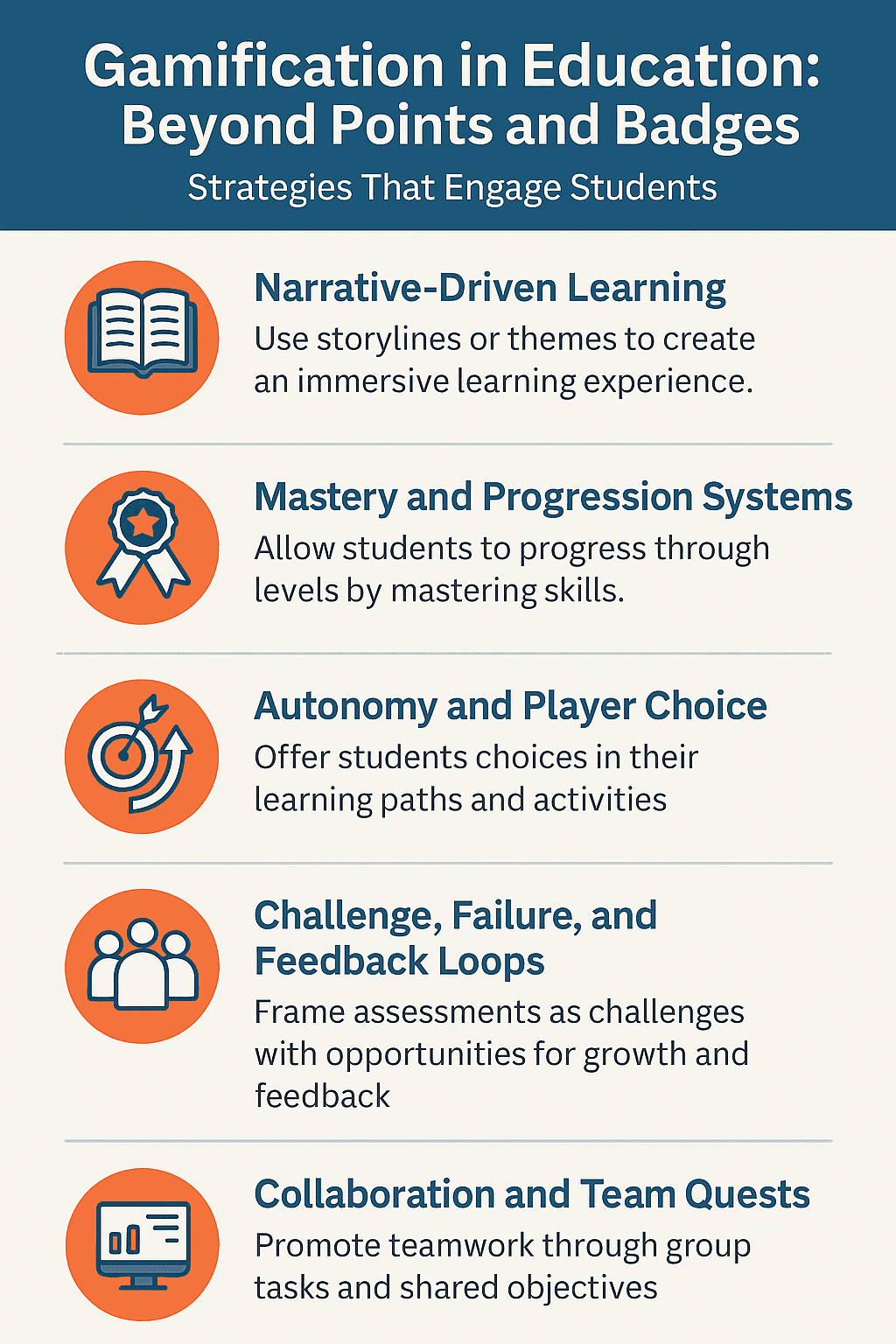Gamification has become a buzzword in education, often associated with leaderboards, badges, and point systems. While these elements can offer short-term motivation, they only scratch the surface of what gamification can truly achieve. The real power of gamification in education beyond points and badges lies in its ability to transform the learning experience into something meaningful, immersive, and sustained.
In this blog post, we explore advanced gamification strategies that go beyond simple rewards to genuinely increase student engagement, deepen understanding, and foster long-term motivation.
The Impact of Real-World Scenarios in Business Education
What Is Gamification in Education?
Gamification is the integration of game mechanics into non-game environments—like classrooms or online learning platforms—to motivate and engage learners. At its core, it involves applying elements such as goals, feedback loops, progression systems, and autonomy to create a more interactive and enjoyable learning experience.
Why Move Beyond Points and Badges?
While points and badges provide extrinsic motivation, they often fail to nurture intrinsic motivation or deeper cognitive engagement. When overused or poorly aligned with learning goals, they can become superficial or even counterproductive.
To harness the true potential of gamification in education, we must incorporate:
- Meaningful narratives
- Learner autonomy and choice
- Levels of challenge and mastery
- Social connection and collaboration
- Real-world relevance
1. Narrative-Driven Learning
What it is:
Narrative adds a storyline or theme to learning. Rather than presenting topics as isolated units, the course becomes an unfolding journey where students are characters in an overarching mission.
Example:
In a history class, students are “time travellers” trying to correct historical injustices. Each lesson is a quest involving primary sources, debates, and strategy decisions.
Benefits:
- Enhances emotional investment
- Encourages contextual learning
- Makes abstract topics relatable
2. Mastery and Progression Systems
What it is:
Instead of a one-size-fits-all grading system, gamification encourages mastery through levels or skill trees. Students “level up” when they demonstrate competence, not simply when they complete tasks.
Example:
A language course includes tiers of achievement for writing, speaking, and listening. Students can unlock advanced challenges only after mastering foundational skills.
Benefits:
- Promotes deeper understanding
- Encourages persistence and growth mindset
- Shifts focus from marks to mastery
3. Autonomy and Player Choice
What it is:
Games are most engaging when players can choose their path. Similarly, in education, offering students choices builds agency and increases ownership of their learning.
Example:
In a gamified science unit, students choose between different learning quests (e.g., lab experiments, video creation, model building) that all align with the same objective.
Benefits:
- Accommodates different learning styles
- Increases motivation and curiosity
- Supports differentiated instruction
4. Challenge, Failure, and Feedback Loops
What it is:
Good games embrace failure as part of the process, offering continuous feedback and second chances. In gamified education, assessments can be framed as challenges with iterative improvement.
Example:
A maths game lets students attempt problem sets with immediate feedback. They can retry failed levels with new hints or tools.
Benefits:
- Reduces fear of failure
- Builds resilience
- Supports formative assessment
5. Collaboration and Team Quests
What it is:
Gamification isn’t always competitive. Team-based quests foster collaboration, communication, and collective problem-solving.
Example:
In a literature class, student teams “unlock” chapters of a mystery novel by solving riddles or completing creative writing tasks.
Benefits:
- Builds peer relationships
- Encourages cooperative learning
- Makes learning more social and dynamic
6. Real-World Relevance and Simulation
What it is:
Many games simulate real-world scenarios. Educational gamification can apply this by embedding content in authentic contexts and decision-making processes.
Example:
In a business studies module, students run a virtual company, managing marketing, operations, and ethics. Each decision affects the company’s success and stakeholder satisfaction.
Benefits:
- Promotes critical thinking
- Bridges theory and practice
- Enhances employability skills
Tips for Successful Gamification in 2025
- Align game mechanics with learning outcomes, not just engagement
- Combine gamification with active learning strategies (problem-based learning, flipped classroom, etc.)
- Use data analytics from gamified platforms to inform personalised feedback
- Prioritise inclusion and accessibility in game design
- Include reflection as part of the gamified process to deepen learning
Conclusion
Effective gamification in education beyond points and badges is not about turning learning into a game—it is about using the psychology of games to make learning more immersive, meaningful, and student-centred. By tapping into storytelling, mastery, autonomy, collaboration, and challenge, educators can create experiences that not only engage but also empower learners.
As we move further into 2025 and beyond, gamification done right has the potential to redefine education—making it not just informative, but transformative.
Visit The Case HQ for 95+ courses
Read More:
Case Studies vs. White Papers: What’s the Difference and When to Use Each?
How Published Research Transforms Technological Advancements
Unraveling the Mystery of Case Studies in Psychology
The Role of Case Studies in Environmental Impact Assessments
Why Research Publications are Critical in Understanding Global Health Trends
Exploring the Real-World Impact of Case Studies in Urban Planning
Case Studies in Sports: A Game-Changing Approach
Navigating Case Studies in AI and Machine Learning
The Impact of Case Studies on Women’s Empowerment Initiatives



Responses